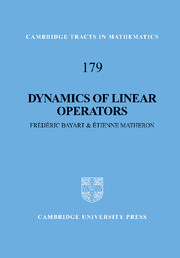Book contents
- Frontmatter
- Contents
- Introduction
- 1 Hypercyclic and supercyclic operators
- 2 Hypercyclicity everywhere
- 3 Connectedness and hypercyclicity
- 4 Weakly mixing operators
- 5 Ergodic theory and linear dynamics
- 6 Beyond hypercyclicity
- 7 Common hypercyclic vectors
- 8 Hypercyclic subspaces
- 9 Supercyclicity and the Angle Criterion
- 10 Linear dynamics and the weak topology
- 11 Universality of the Riemann zeta function
- 12 An introduction to Read-type operators
- Appendices
- References
- Notation
- Author index
- Subject index
5 - Ergodic theory and linear dynamics
Published online by Cambridge University Press: 10 December 2009
- Frontmatter
- Contents
- Introduction
- 1 Hypercyclic and supercyclic operators
- 2 Hypercyclicity everywhere
- 3 Connectedness and hypercyclicity
- 4 Weakly mixing operators
- 5 Ergodic theory and linear dynamics
- 6 Beyond hypercyclicity
- 7 Common hypercyclic vectors
- 8 Hypercyclic subspaces
- 9 Supercyclicity and the Angle Criterion
- 10 Linear dynamics and the weak topology
- 11 Universality of the Riemann zeta function
- 12 An introduction to Read-type operators
- Appendices
- References
- Notation
- Author index
- Subject index
Summary
Introduction
So far, we have obtained hypercyclic vectors either by a direct construction or by a Baire category argument. The aim of this chapter is to provide another way of doing so, using ergodic theory. This will link linear dynamics with measurable dynamics. We first recall some basic definitions from ergodic theory. The classical book of P. Walters [235] is a very readable introduction to that area.
The first important concept is that of invariant measure.
DEFINITION 5.1 Let (X, B, μ) be a probability space. We say that a measurable map T : (X, B, μ) → (X, B, μ) is a measure-preserving transformation, or that μ is T-invariant, if μ(T–1(A)) = μ(A) for all A ∈ B.
Measure-preserving transformations already have some important dynamical properties. In particular, the famous Poincaré recurrence theorem asserts that if T : (X, μ) → (X, μ) is measure-preserving then, for any measurable set A such that μ(A) > 0, almost every point x ∈ A is T-recurrent with respect to A, which means that Tn(x) ∈ A for infinitely many n ∈ N.
Now the central concept in linear dynamics is not recurrence but transitivity.
- Type
- Chapter
- Information
- Dynamics of Linear Operators , pp. 95 - 133Publisher: Cambridge University PressPrint publication year: 2009

